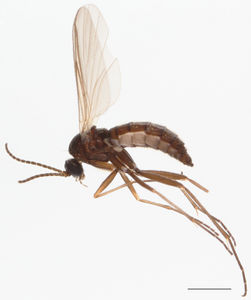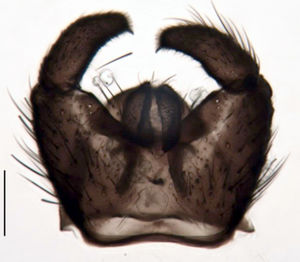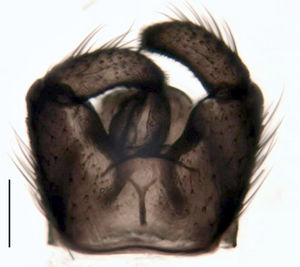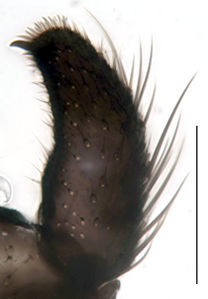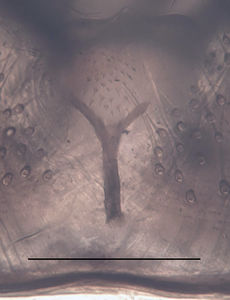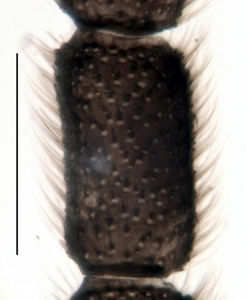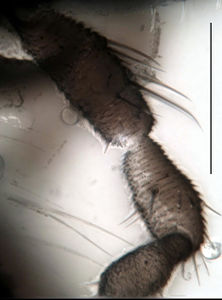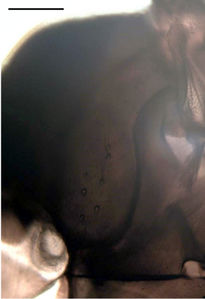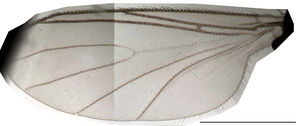Trichosiopsis hirsutissima
Ordo: Diptera
Familia: Sciaridae
Genus: Trichosiopsis
Name
Trichosiopsis hirsutissima (Strobl, 1895) stat rev. – ZooBank link
- Sciara hirsutissima Strobl, 1895[1]: 131
Type material
Lectotype: ♂, 23.06. [not 23.05.], leg. Strobl, 3002 in NMBA; designated by Menzel (1992[2]: 237)
Type locality
Austria, Styria, Admont
Paralectotypes
1 ♀, same data as holotype; 1 ♂, Seitenstetten, leg. Strobl [both in NMBA]
Barcoded material
| Stadium | Country | Province | Locality | Habitat | Method | Date | Collector | Collection Number | Collection | Latitude | Longitude | Elevation (m) |
|---|---|---|---|---|---|---|---|---|---|---|---|---|
| 1 ♂ (holotype) | Austria | Tyrol | Sellrain, Stubai Alps, Gleirschjöchl | alpine heather | sweep netting | 27.07.2013 | Kai Heller | ZFMK-TIS-2513656 | ZFMK | 47.1486111 | 11.055 | 2400 |
| 1 ♂ | Austria | Tyrol | Sellrain, Stubai Alps, Gleirschjöchl | alpine heather | sweep netting | 27.07.2013 | Kai Heller | ZFMK-TIS-2513657 | ZFMK | 47.1486111 | 11.055 | 2400 |
| 1 ♂ | Austria | Tyrol | Sellrain, Stubai Alps, Gleirschjöchl | alpine heather | sweep netting | 27.07.2013 | Kai Heller | ZFMK-TIS-2515070 | ZFMK | 47.1486111 | 11.055 | 2400 |
| 1 ♂ | Austria | Tyrol | Sellrain, Stubai Alps, Gleirschjöchl | alpine heather | sweep netting | 27.07.2013 | Kai Heller | ZFMK-TIS-2515069 | ZFMK | 47.1486111 | 11.055 | 2400 |
| 1 ♂ | Austria | Tyrol | Sellrain, Stubai Alps, Gleirschjöchl | alpine heather | sweep netting | 27.07.2013 | Kai Heller | ZFMK-TIS-2515074 | ZFMK | 47.1486111 | 11.055 | 2400 |
| 1 ♀ | Austria | Tyrol | Sellrain, Stubai Alps, Gleirschjöchl | alpine heather | sweep netting | 27.07.2013 | Kai Heller | ZFMK-TIS-2515073 | ZFMK | 47.1486111 | 11.055 | 2400 |
| 1 ♀ | Austria | Tyrol | Sellrain, Stubai Alps, Gleirschjöchl | alpine heather | sweep netting | 27.07.2013 | Kai Heller | ZFMK-TIS-2515072 | ZFMK | 47.1486111 | 11.055 | 2400 |
| 1 ♀ | Austria | Tyrol | Sellrain, Stubai Alps, Gleirschjöchl | alpine heather | sweep netting | 27.07.2013 | Kai Heller | ZFMK-TIS-14927 | ZFMK | 47.1486111 | 11.055 | 2400 |
| 1 | Switzerland | Uri / Wallis | Furkapass, APFOR-station | Christian Körner | 24424-A09 | MZH | 46.577 | 8.421 |
Other material studied
Austria: 1 ♀, Tyrol, Sellrain, Stubai Alps, Gleirschjöchl, Heller, 27.07.2013, PKHH 8250; Italy: 5 ♂, South Tyrol, Stilfzer Joch NP, Glumser Alm, alpine Grasheide, Lange & Ziegler, 29.06.-04.07.2005, SDEI 3319–3323; 5 ♂, Suldental bei Schmelz, hochmontaner Fichten-Lärchen-Wald, Malaise trap, Lange & Ziegler, 21.-31.05.2005, SDEI 2495.
Description (male)
Head. Eye bridge 4–6 rows of facets. Antenna unicolour. LW-index of 4th flagellomere 1.6–2; neck 0.08–0.16 × segment width; transition of basal part to neck pronounced. Colour of neck unicolour. Antennal setae as long as segment width; of normal strength; dense; salient. Palpus darkened; of normal length; palpomeres 3. First palpomere elongate; with 5–8 setae; with only sparse sensilla. Second palpomere elongate. Third palpomere as long as first. Thorax. Colour dark brown, or brown. Notum unicolour. Thoracic setae long and strong; black. Posterior pronotum setose. Postpronotal setae 6–9; strong. Mesothoracic sclerites setose. Laterotergite with 6–9 setae. Legs. Colour brown. Hind coxa of same colour as femora. Setae on front coxa pale. Front tibial organ as patch of setae; dark; front tibial organ not bordered. Tibial setae on hind legs normal, shorter than tibial width. Tibial spurs of equal length. Claws untoothed. Wing. Wing slightly darkened; of normal shape. Wing membrane without macrotrichia. Wing venation weak, with faint stM. M-fork of normal shape. R1 ending clearly after base of m-fork; posterior veins with macrotrichia; stM mostly with macrotrichia; CuA1 and CuA2 mostly with macrotrichia; bM setose; r-m mostly setose; bM:r-M 0.75–0.9; st-Cu:bM 0.5–0.7; R1:R 1.3–1.6; c:w 0.6–0.8. Halter darkened; of normal length. Abdomen. Abdominal setae strong; on tergites pale, or dark and pale; on sternites white. Hypopygium concolour with abdomen; LW-index 0.6–0.8. Base of gonocoxites with weak setae; gonocoxites broadly separated; inner margin of gonocoxites typically U-shaped; inner membrane of hypopygium scarcely setose; ventral margin of gonocoxite with short setae. Gonostylus elongate; LW-index 2.3–2.6; Inner margin concave; apex tapered, or with one obtuse angle. Apical tooth present; without internal structure; of medium strength; LW-Index 2.3–2.8. Awl-like setae normal; present beneath apical tooth. Megasetae absent. Whiplash-hair absent. Tegmen 0.3–0.6 × longer than broad; rectangular with rounded edges; without special features; central process absent. Length of ejaculatory apodeme/hypopygium 20–28 %; base of ejaculatory apodeme present. Field with aedeagal teeth inconspicuous. Measurements. Body size 3–3.8 mm. Hind tibia 1.5–1.65 mm. Wing length 2.8–3.3 mm.
Diagnosis
Morphologically, Tr. hirsutissima resembles Trichosiopsis hispida by the dark-coloured legs, the narrow wings and the presence of setae on the laterotergite. The species belongs to the Trichosiopsis trochanterata complex and here to the species with a setose laterotergite. Tr. hirsutissima can be distinguished from Tr. hispida by the longer and less tapered gonostylus and the tendency to having a few more setae on the laterotergite (6-9 instead of 3-5). The wings are less darkened and the anal lobe is not reduced. Trichosiopsis coarctata is distinguished by a more parallel, not tapered gonostylus and by more distinctly bi-coloured fore femora.
DNA Barcoding
The COI sequence is assigned to BIN BOLD:ACM3280 (average distance 1.48%, max. 2.91%, n=9, K2P: 8.62%).
Etymology
lat. hirsutus = hairy; superlative: hirsutissima = most hairy.
Discussion
Species of the Tr. trochanterata complex are extremely uniform and was previously considered to be synonymous to Tr. trochanterata by Mohrig & Menzel (1992[3]: 54–55) By the hypopygium and most body characters Tr. hirsutissima is practically not distinguishable from other similar species. However, it bears some distinct setae on the laterotergite. Such setae are also observed in Trichosiopsis hispida and in Trichosiopsis coarctata.
It may be argued, that distinguishing Tr. hirsutissima as distinct species based on so few morphological differences is an oversplitting. But the comparison of DNA sequence of COI with a genetic difference of more than 9% to Tr. trochanterata, Tr. coarctata and Tr. hispida shows without doubt its clear distinctiveness. Specimens of three very similar species or subspecies Tr. hirsutissima, Trichosiopsis hispida sellrain and Trichosiopsis coarctata requaesta were collected together at the same time at the same place. Trichosiopsis incognita is one more known alpine species in the trochanterata complex. This leads to the assumption, that particularly in the Alps a lot more species of this complex might be expected. With the apparent multitude of Tr. trochanterata-like species in higher altitudes, the traditional morphological species concept is obviously reaching its limits and the support of genetic methods is indispensable.
Distribution
Austria[1], Italy, Switzerland.
Images
|
References
- ↑ 1.0 1.1 Strobl, G. 1895: Die Dipteren von Steiermark. III. Theil. Diptera, Nematocera. Mittheilungen des Naturwissenschaftlichen Vereines für Steiermark, 31(1894), 121–243. BHL
- ↑ Menzel, F. 1992: Beiträge zur Taxonomie und Faunistik der paläarktischen Trauermücken (Diptera, Sciaridae). Teil I. - Die Stroblschen Sciaridentypen des Naturhistorischen Museums des Benediktinerstifts Admont. Beiträge zur Entomologie, 42(2).
- ↑ Mohrig, W.; Menzel, F. 1997: Revision der paläarktischen Arten von Trichosia Winnertz sensu Tuomikoski, 1960 (Diptera, Sciaridae). – Teil II. Gattungen Leptosciarella Tuomikoski, 1960 und Trichodapus gen. nov. Studia dipterologica, 4(1), 41–98.
